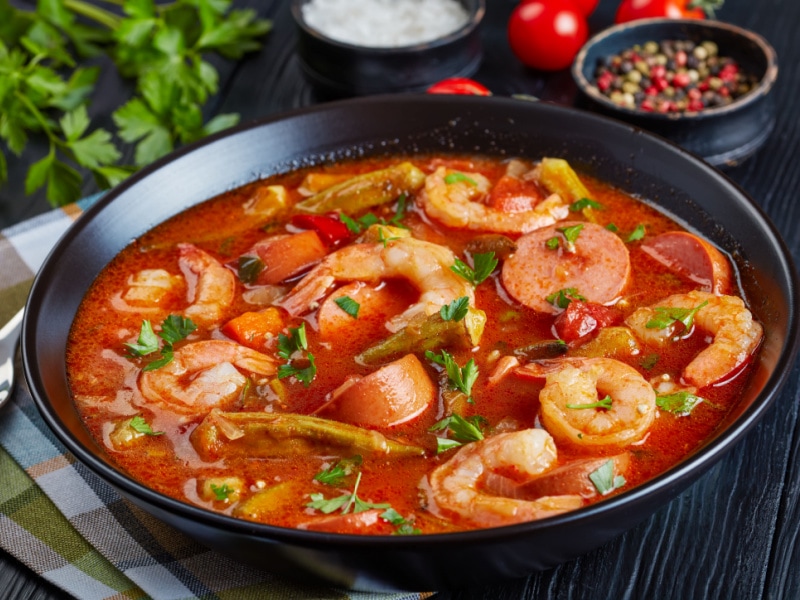Gumbo and jambalaya are both popular Creole dishes from Louisiana, but they have key differences. Gumbo is a thick, soup-like stew typically made with a roux, okra, and a variety of meats or seafood.
Jambalaya is a rice dish cooked with meat (like sausage, chicken, or shrimp), vegetables, and spices, with a tomato-based sauce.

The main distinction is that gumbo is more of a soup, while jambalaya is a rice-based dish with a drier texture.
Each dish boasts a rich history and comforting flavors with unique tales to tell.
Jambalaya vs. Gumbo (What’s the Difference?)
Jambalaya and Gumbo are both popular Louisiana dishes.
Gumbo, a thick and hearty soup or stew, gains its thickness and flavor from a roux. This savory dish typically includes a combination of meats like chicken, sausage, and seafood.
It combines the “holy trinity” of vegetables: celery, bell peppers, and onions, plus a variety of spices. Gumbo is traditionally served over rice, allowing the flavors to meld together deliciously.
Jambalaya is a one-pot rice-based dish with a drier consistency. The rice is cooked alongside a medley of meats, seafood, vegetables, and spices.
It’s a quicker and more straightforward dish to prepare compared to the rich flavors of gumbo. Both will warm your heart with every bite.

What Do Gumbo and Jambalaya Have in Common?
Gumbo and jambalaya have several similarities, as they’re both iconic dishes from Louisiana. Here are the key aspects they have in common:
1. Louisiana Origin: Gumbo and jambalaya have roots in Louisiana’s diverse culinary heritage. It combines African, French, Spanish, and Native American influences.
2. Trinity of Vegetables: Both dishes use the “holy trinity” of vegetables: celery, bell peppers, and onions as a flavor base.
3. Meats and Seafood: While the specific types of meats and seafood can vary, both dishes boast a delicious medley of proteins.
4. Served with Rice: Although the rice is prepared differently in each dish, they’re both when paired with rice.
5. Influences from African, French, and Spanish Cuisines: Both dishes reflect the multicultural influences from African, French, and Spanish culinary traditions.

What is Jambalaya?
Jambalaya is a rice-based dish that also originated in Louisiana. This dish has influences from Spanish and French cuisines (mainly Spanish paella and French jambalaia).
It includes a variety of ingredients, such as meats and vegetables cooked together with rice and broth. Both variations have that distinctive kick and are teeming with rich flavors.
Key features of jambalaya:
- A rice-based dish
- Contains a variety of meats and vegetables
- Cooked all together in one pot
Variations of Jambalaya
1. Creole Jambalaya
This version typically features a tomato-based sauce, giving it a slightly reddish hue. It’s made by sautéing the “holy trinity” of vegetables with aromatic spices.
The dish combines succulent shrimp, tender chicken, and smoky andouille sausage, creating a symphony of savory flavors.
Served over fluffy white rice, Creole jambalaya is a delicious harmony of tastes and textures. It showcases the indulgent and soulful nature of New Orleans cuisine.
2. Cajun Jambalaya
Cajun jambalaya is a rustic and hearty variation hailing from the rural bayous of Louisiana.
This version differs from Creole jambalaya in its absence of tomatoes. Instead, it relies on a dark and rich roux, cooked until it reaches a deep mahogany color.
The “holy trinity” of vegetables and proteins provides a zesty foundation for this irresistible dish.
Served over rice, Cajun jambalaya exudes a warm and comforting essence. It embraces the rustic essence of the Louisiana countryside.
3. White Jambalaya
White jambalaya is a unique variation that differentiates itself from traditional red-colored versions.
This interpretation omits tomatoes, focusing on a lighter and more delicate flavor profile. Instead of bold tomato sauce, it uses a savory broth or stock.
White Jambalaya often features a mix of chicken, shrimp, and sometimes crab or crawfish. It provides a refreshing take on this Louisiana classic.

What is Gumbo?
Gumbo is a type of stew that originated in Louisiana. It uses a roux (a mixture of flour and fat) to thicken the stew.
This hearty stew is loaded with chicken, sausage, and salt meat if it’s a meat gumbo. For seafood gumbo, it combines crab, shrimp, and oyster.
Gumbo is typically served over rice, which soaks up its delicious flavors.
Key features of gumbo:
- Starts with a roux
- Contains a wide variety of meats, seafood, and vegetables
- Thickened with okra or file powder
- Served as a soup or stew, usually over rice
Variations of Gumbo
1. Creole Gumbo
Creole gumbo is a luscious and rich gumbo variation that features the bright flavors of tomatoes. It incorporates a variety of meats such as chicken, shrimp, andouille sausage, and seafood.
It’s loaded with okra or filé powder for thickening, creating a complex and savory flavor profile.
Served over fluffy white rice, Creole gumbo delights the tastebuds with its robust and soulful taste.
2. Cajun Gumbo
Cajun gumbo is a rustic and hearty gumbo infused with warm, comforting flavors. This variation typically begins with a darker roux, adding a deep, nutty flavor.
It incorporates a combination of meats, including duck, chicken, and andouille sausage. Served over rice, this hearty gumbo delivers a comforting and robust experience.
This version is well-loved in Southern Louisiana for its deep, rustic undertones.
3. Gumbo Z’Herbes
Gumbo z’herbes, also known as “green gumbo,” is a vegetarian version.
Unlike other gumbos, this variation relies solely on vegetables for its flavor. It’s loaded with turnips, mustard greens, spinach, and more.
It incorporates the “holy trinity” of vegetables and a simple roux, omitting meats and seafood.

Creole or Cajun?
The choice between Creole and Cajun cuisine depends on the type of flavors you enjoy. Both are iconic and delicious but have distinct characteristics.
If you enjoy rich and complex flavors, Creole cuisine might be more to your liking. But Cajun cuisine is the way to go if you prefer hearty and robust flavors.
Many people appreciate elements from both Creole and Cajun cuisines. They each contribute unique and mouthwatering aspects to Louisiana’s rich culinary heritage.










